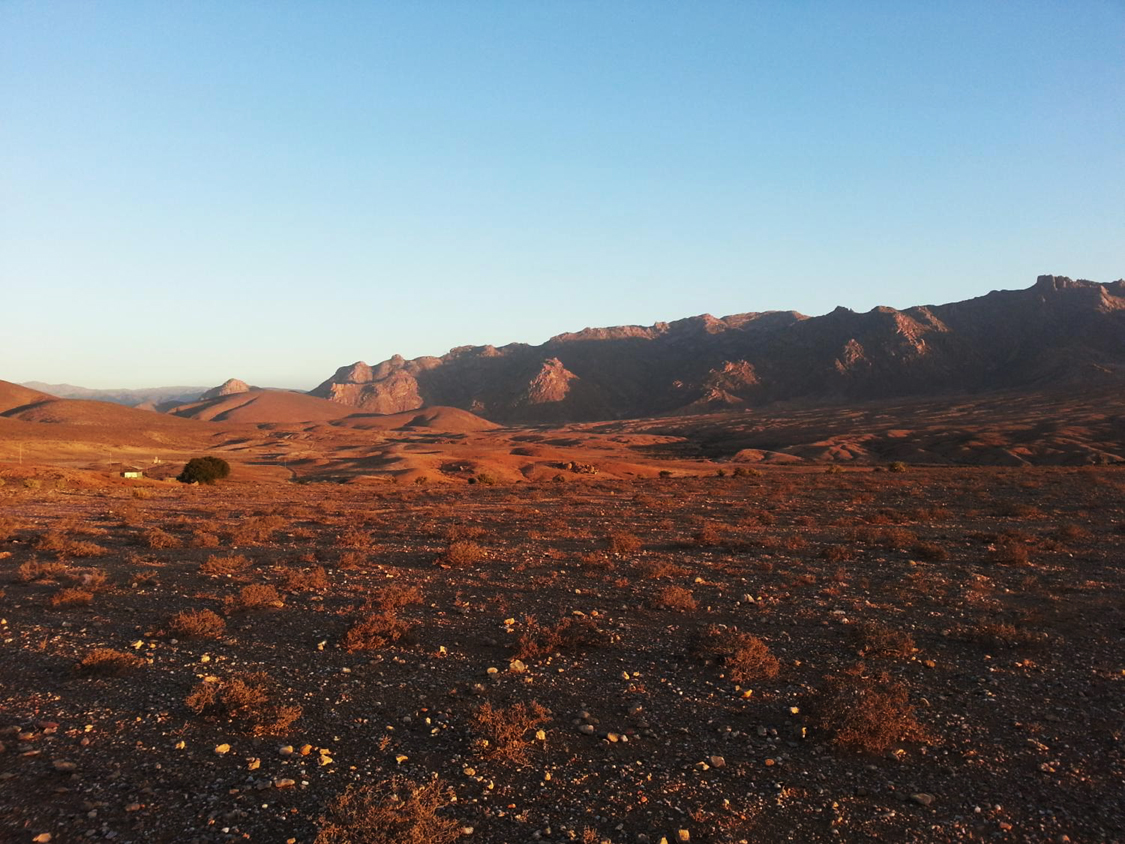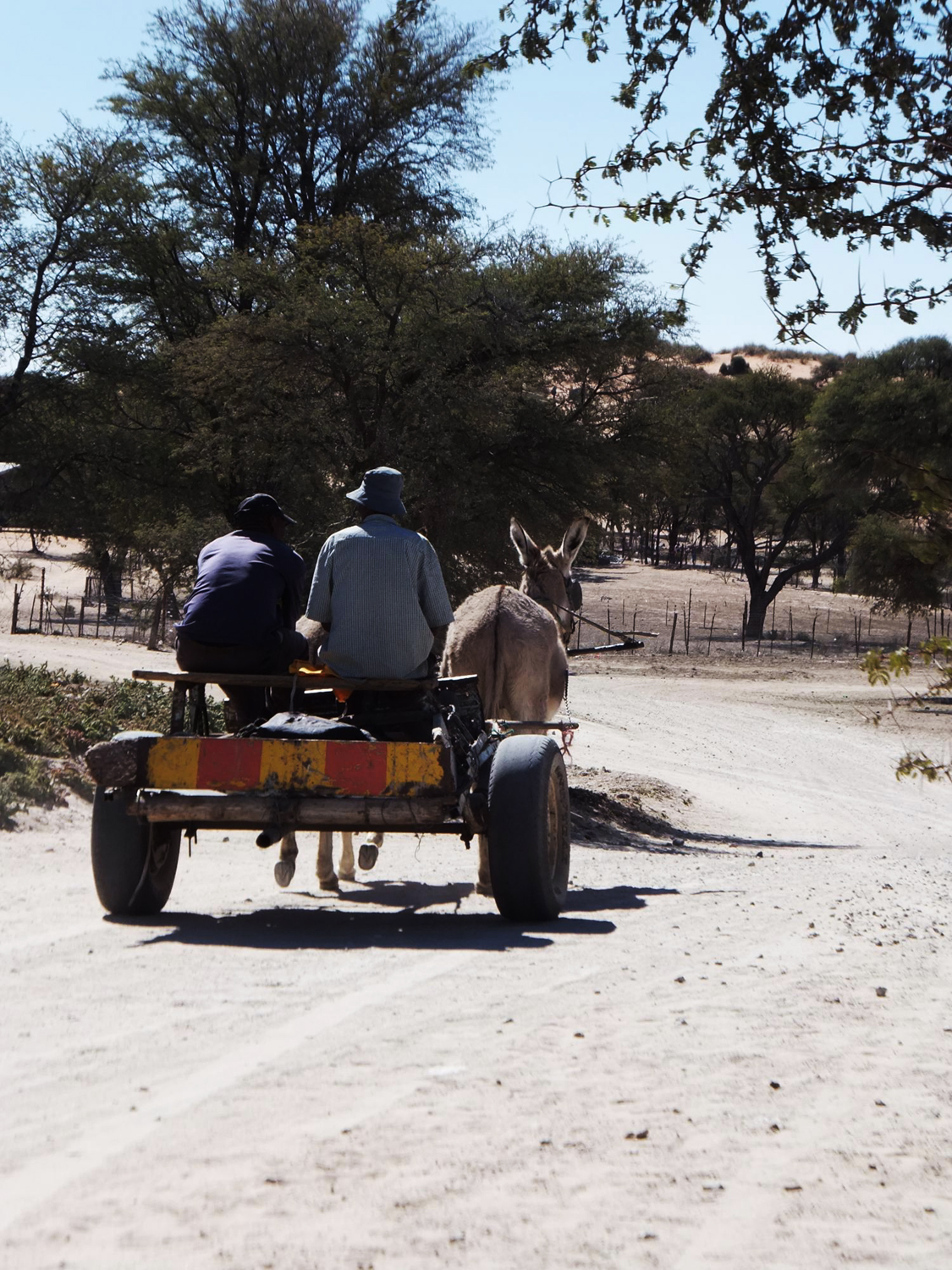


An article in phys.org - Genetics of African KhoeSan populations maps to Kalahari Desert geography - reports on the key factors influencing the genetic makeup of human groups in southern Africa; geography and ecology.

Landscape of the Richtersveld Community Conservancy, South Africa. Image: Brenna Henn
As discussed in the journal Genetics, a publication of the Genetics Society of America, by investigating the ancestries of twenty-two KhoeSan groups, including new samples from the Nama and the ≠Khomani, researchers conclude that the genetic clustering of southern African populations is closely tied to the ecogeography of the Kalahari Desert region.
Fine-Scale Human Population Structure in Southern Africa Reflects Ecogeographic Boundaries
C. Uren et al,
Genetics (2016).DOI: 10.1534/genetics.116.187369
The name KhoeSan refers to several 'indigenous populations' in southern Africa; KhoeSan people speak 'click' languages and include both hunter-gatherer groups and pastoralists. They are genetically distinct and strikingly isolated from all other African populations, suggesting they were among the first groups to diverge from the ancestors of all humans.
Genetics of African KhoeSan populations linked to #Kalahari Desert geography #SouthAfrica https://t.co/PChjk6TIe4 pic.twitter.com/RLeaZdOwjG
— Bradshaw Foundation (@BradshawFND) September 7, 2016
A Nama man in the Richtersveld, South Africa. Image: Justin Myrick
Much scientific interest has focused on the KhoeSan as researchers try to reconstruct this early divergence; however, little genetic material was collected until the past decade.
Brenna Henn, of Stony Brook University in New York, has been studying southern African population genetics for over a decade.
She states that in the past all indigenous southern Africans have been placed into a single group - often called 'Bushmen'. However, the KhoeSan includes many distinct populations. She and her team set out to explore genetic diversity between the KhoeSan groups in the area.
Genetic patterns determined by geography and language - Henn states that genetic differences between human populations are strongly correlated with their linguistic histories, and both of these factors are also linked with geography. Indeed, the ecology and geography together are likely a better explanation for the genetic differentiation between groups than either linguistic differences or method of subsistence (hunting/gathering or farming). Ecogeography is the key.

The Khomani San community in the southern Kalahari Desert, South Africa. Image: Brenna Henn
Henn and her colleagues analyzed genetic information from the KhoeSan. They collected genome-wide data from three south African populations: the Nama, the ≠Khomani San, and the South African Coloured (SAC) group. Their analysis also included samples from 19 other southern African populations. The research revealed that the geography of the Kalahari Desert was closely tied to the population structure. The outer rim of the Kalahari Desert presented a barrier to genetic mixing, while populations that live within the Kalahari basin mixed more freely.
This meant a more complex history for the KhoeSan populations than originally thought. Rather than a north-south divergence pattern, five primary ancestries were identified in the region, based on a geographically complex set of migration events responsible for the heterogeneity.
Despite research restrictions - there were more KhoeSan populations who were not sampled due to difficulties such as complex politics of the region in the post-Apartheid era - the strands of information such as linguistics, subsistence, geography, genetics and archaeology are providing a greater understanding of the genetic makeup of human groups in southern Africa, even if they are not always easily reconciled. Henn states that to fully understand the huge amount of diversity in southern Africa populations - the groups speak differently, look distinct, and have divergent genetic histories - much more research is required.
Visit the South Africa Rock Art Archive:
http://www.bradshawfoundation.com/south_africa/index.php
by Bradshaw Foundation
Thursday 04 July 2024
by Bradshaw Foundation
Monday 01 July 2024
by Bradshaw Foundation
Wednesday 20 March 2024
by Bradshaw Foundation
Monday 30 May 2022
by Bradshaw Foundation
Wednesday 19 January 2022
by Bradshaw Foundation
Thursday 06 January 2022
by Bradshaw Foundation
Tuesday 21 March 2023
by Bradshaw Foundation
Tuesday 07 February 2023
by Bradshaw Foundation
Thursday 19 May 2022
by Bradshaw Foundation
Monday 04 December 2023
by Bradshaw Foundation
Friday 30 June 2023
by Bradshaw Foundation
Thursday 06 April 2023
by Bradshaw Foundation
Friday 14 July 2023
by Bradshaw Foundation
Monday 22 November 2021
by Bradshaw Foundation
Tuesday 12 July 2016
by Bradshaw Foundation
Monday 27 November 2023
by Bradshaw Foundation
Friday 07 October 2022
by Bradshaw Foundation
Friday 05 November 2021
by Bradshaw Foundation
Thursday 04 July 2024
by Bradshaw Foundation
Monday 01 July 2024
by Bradshaw Foundation
Wednesday 20 March 2024
by Bradshaw Foundation
Monday 30 May 2022
by Bradshaw Foundation
Wednesday 19 January 2022
by Bradshaw Foundation
Thursday 06 January 2022
by Bradshaw Foundation
Tuesday 21 March 2023
by Bradshaw Foundation
Tuesday 07 February 2023
by Bradshaw Foundation
Thursday 19 May 2022
by Bradshaw Foundation
Monday 04 December 2023
by Bradshaw Foundation
Friday 30 June 2023
by Bradshaw Foundation
Thursday 06 April 2023
by Bradshaw Foundation
Friday 14 July 2023
by Bradshaw Foundation
Monday 22 November 2021
by Bradshaw Foundation
Tuesday 12 July 2016
by Bradshaw Foundation
Monday 27 November 2023
by Bradshaw Foundation
Friday 07 October 2022
by Bradshaw Foundation
Friday 05 November 2021
by Bradshaw Foundation
Wednesday 22 May 2024
by Bradshaw Foundation
Friday 10 November 2023
by Bradshaw Foundation
Thursday 12 January 2023
Friend of the Foundation











